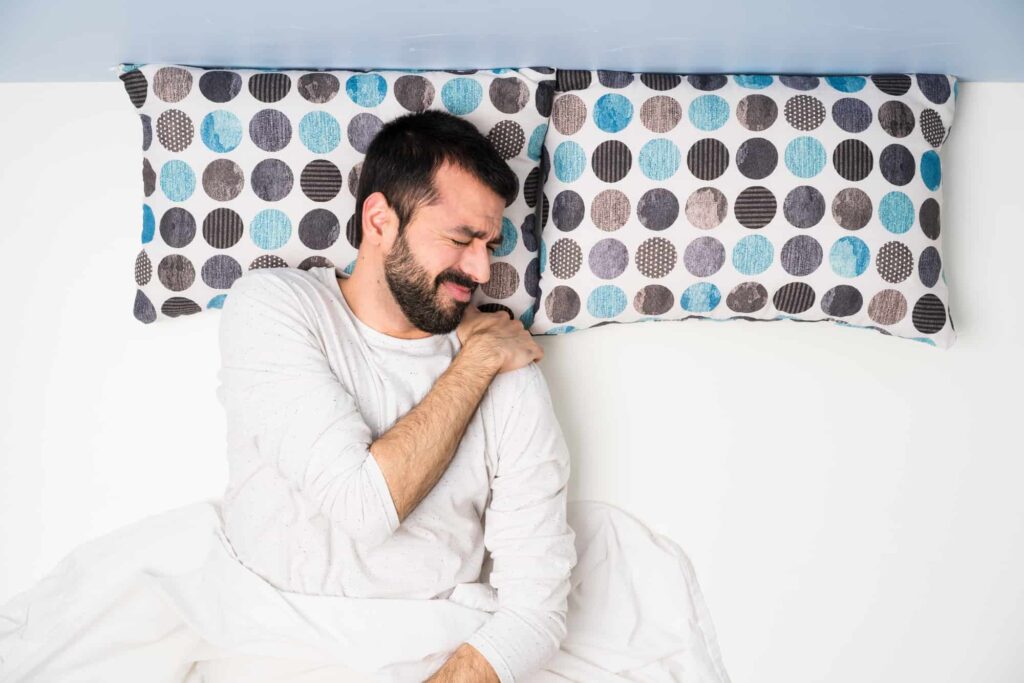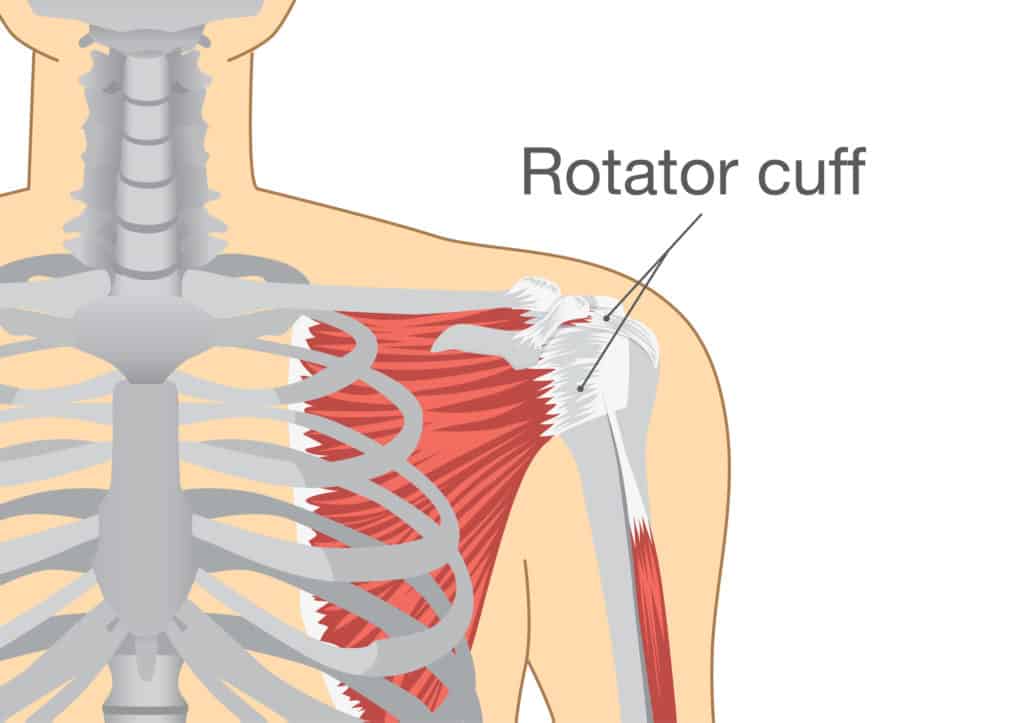
Am I Getting Shoulder Pain From The Way I Sleep?
Are you having trouble falling asleep because of a painful shoulder?
Mystified about what the cause might be and wondering what to do about it?
Sadly, insomnia and disturbed sleep are common complaints among patients with shoulder pain.
It’s a double-edged sword because lack of sleep can also exacerbate chronic pain conditions.
We call it the pain-sleep cycle. Long-term lack of good quality sleep also affects your immune system.
It increases your susceptibility to other chronic health conditions and creates a low-energy state inside the body. It can also cause anxiety, depression, and chronic fatigue.
When you have shoulder pain, sleeping on the painful shoulder can be uncomfortable. Still, we’re creatures of habit, and falling asleep can be more difficult if you change your routine – i.e., try to sleep on a different shoulder.
Unfortunately, in some instances, this alternative sleeping position can also contribute to new aches and pains because your body is not used to it.
It’s a vicious circle.
There are various causes of shoulder pain. However, if you sleep in an awkward position, then the way you sleep could be the cause for you. If it is – or if there is any other reason for your shoulder pain – we can help.
So, let’s explore what’s going on for you and what you can do about it.
How Shoulder Pain Can Relate To Your Sleeping Position

Some of the sleeping positions we adopt can cause stress on the shoulder, with the main culprit being sleeping on your side.
This position can cause shoulder pain because it transfers a lot of weight from your torso and upper body onto your shoulder.
But it isn’t just sleeping on your side that causes shoulder problems. Studies show the link between the position we sleep in and its relation to shoulder pain. But there is a strong association between side sleeping and shoulder pain particularly.
For example, more than 60% of participants in one study who slept on their side reported that they suffered from shoulder pain.
However, we cannot attribute shoulder pain to sleeping on your side as there are many other reasons.
But if you suffer from any of the medical conditions below, then you might want to reconsider sleeping on your side because it can aggravate the pain and other symptoms:
Rotator cuff injury: A group of tendons forms the rotator cuff within the shoulder.
This group of tendons links the shoulder blade to the upper arm bone and keeps it fixed in its socket.
A rotator cuff injury occurs if the tendons get inflamed and swollen (tendinitis) or if they rupture or tear. This may happen due to the following:
- Picking up something extremely heavy with a sudden jerk
- Falling with your arm stretched out
- Playing sports that involve using the shoulder joint
- Carrying out repetitive movements for an extended period
Some of the symptoms of a rotator cuff injury are:

A deep dull ache in the shoulder
Decrease in your range of motion due to stiffness
Pain that intensifies with specific movements
Discomfort while resting on the affected shoulder
Shoulder bursitis: The shoulder joint tissue is cushioned with fluid filled-sacs known as bursae. When they get inflamed, it is called bursitis, with the shoulder being the most frequent location for the condition. This generally occurs due to an injury or repetitive movements that exert the joint.
The symptoms of shoulder bursitis are:
Tenderness and pain in the shoulder
Pain arising from pressure, like lying down
Any movement exacerbates the pain
Your shoulder is stiff
There is redness with swelling

Shoulder impingement syndrome: This syndrome causes the rotator cuff soft tissues to experience friction or get caught on the bone or surrounding tissues when you move your arm. This condition can occur due to the following:
Tendinitis, where the tendons swell up
Development of bone spurs with aging
The bursa (fluid-filled sacs) getting inflamed
Tissue getting caught in the acromion bone of the shoulder joint
The symptoms of shoulder impingement syndrome are:
Pain occurs at the outer section or top part of the shoulder
The affected arm or shoulder feels weak
Difficulty and pain when attempting to lift your arm above the head
The pain increases at night, especially if you sleep on the affected shoulder
Osteoarthritis: In this condition, the cartilage within the shoulder bones begins to wear off. This degeneration can happen to various joints in the body, including the shoulder. While osteoarthritis of the shoulder mostly happens due to aging. In some cases, it may occur due to shoulder dislocation, injury, or a tear to the rotator cuff.
The symptoms of shoulder osteoarthritis are:
In the early stages, the pain intensifies with movement only. Later it may be sore even after resting/sleeping
A clicking/grinding sound when moving the shoulder
The shoulder becomes stiff with a limited range of motion
Frozen shoulder
A so-called “frozen” shoulder happens when the shoulder joint’s connective tissue thickens, restricting movement.
There is no exact cause determined as yet for this condition. However, we know that the risk of developing a frozen shoulder increases after surgery or an injury when the shoulder is kept immobilized for a long period.
In addition, if you have diabetes, you may be more prone to suffering from this condition.

The symptoms occur in three stages such as:
Freezing: Decrease in range of motion and movement with pain developing
Frozen: Reduction in pain, but moving it isn’t easy, and the shoulder stiffens
Thawing: There is gradual improvement in the range of motion
The pain can intensify in the evenings and cause sleep disruption
If you visit a doctor with a rotator cuff injury, bursitis, shoulder impingement syndrome, frozen shoulder, or osteoarthritis, they’ll probably prescribe icing, rest, and over-the-counter medications or steroid injections for inflammation and pain relief.
But you’re likely to still be in pain weeks later. Treatment from a physical therapist is way more effective and prevents the condition from reoccurring or arthritis from progressing.
We are proud to say we do things differently at RPM Physical Therapy. We prioritize your health and help you avoid popping pain pills.
Instead, we guide you through a range of movements and exercises to increase your range of motion and improve your shoulder’s flexibility and strength.
** In all of the above conditions, surgery is only reserved for severe and chronic cases that do not respond to medication, physical therapy, or alternative treatments. Remember, physical therapy first. Don’t let medical doctors push you into surgery or convince you there isn’t another option.
How To Sleep With Shoulder Pain

If shoulder pain is keeping you awake at night. We would recommend coming to see us, so we can identify the root cause and fix the underlying issue once and for all.
But meanwhile, here are our top tips for getting a better night’s sleep when you have shoulder pain:
Do not sleep on a painful shoulder. Instead, switch to your back, stomach, or the other side to relieve pressure on the affected shoulder.
Use a soft but firm pillow when sleeping. Since we tend to change our sleep positions during the night (without realizing it), place a pillow beneath the affected shoulder to prevent sleeping on that side.
Try to lead an active lifestyle through exercise and daily stretching movements. Exercising every day improves blood circulation, providing more nutrients to the shoulder tendons and tissues while promoting swifter healing of any injury. Gentle stretching movements also relieve pain.
Avoid activities that aggravate the condition if you suffer from recurring shoulder pain.
But most importantly, don’t put up with or ignore shoulder pain. Things can get much worse if you ignore them for too long.
It can even lead you straight to the surgeon’s table because you missed the window of opportunity where physical therapy can correct the issue.
If you’re 40+ or even if you’re much younger but suffering from a complex pain condition. We provide natural, long-lasting relief from stiffness and pain wherever it resides in your body.
To do this, we use soft tissue work, mobility treatment, massage, stretching, and joint manipulation. Our “secret weapons” that are unrivalled anywhere else in the physical therapy industry.
We make a difference fast.
You’re not on your own.
So, instead of putting things off.
Take advantage of our offer of a free Discovery Visit to come and talk to one of our physical therapists about your shoulder issues and get advice on how to fix it.
It’s 100% free of charge, and there is no obligation to book treatment afterward.
Reserve your free spot here now. Places are limited.
Dr. Jonathan Ruzicka is a Manual Therapist whose experience as a private therapist for professional athletes drove him to further his education attaining unparalleled skills in tissue mobility work, performance based rehab, injury prevention, myofacial release and joint mobilization to optimize human performance.
- Physical Therapy for Oak Ridge North Residents Near The Woodlands - November 7, 2025
- 5 Lower Back Pain Stretches to Ease Your Discomfort - August 23, 2024
- How to Avoid Foot and Ankle Pain and Stay Active! - July 26, 2024


